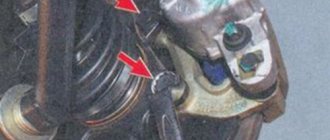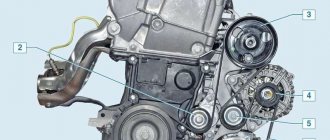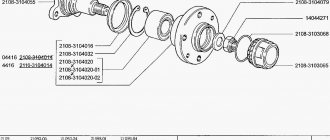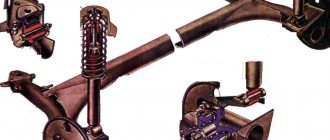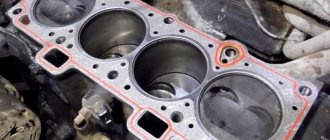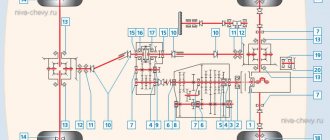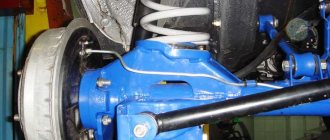Cars admin26.02.2020
In order for the wheel to rotate and stay firmly in place, in addition to the ball joint, the suspension mechanisms include a hub bearing. On Lada Vesta cars there are front and rear bearings, since in some Vestas there are drums at the back, not calipers. Replacing a part on a hundred will cost from 1000 to 2000 rubles. The wheel bearing tends to howl, the first Vesta cars were famous for this disease. As always, the first models come out like raw meat, often inheriting the diseases of previous models. Lada Vesta did not break this tradition. AvtoVAZ even gave an explanatory letter admitting that the front right/left wheel was howling and advised changing the assembly. Below in the article you will find the official letter. The price for the front wheel bearing of a Vesta car starts from 1000 rubles. The part is available for cars with and without abs. True, I have never seen Vesta without abs.
Life hack: Vesta car front and rear wheel bearings - replacement instructions
In order for the wheel to rotate and stay firmly in place, in addition to the ball joint, the suspension mechanisms include a hub bearing. On Lada Vesta cars there are front and rear bearings, since in some Vestas there are drums at the back, not calipers. Replacing a part on a hundred will cost from 1000 to 2000 rubles. The wheel bearing tends to howl, the first Vesta cars were famous for this disease. As always, the first models come out like raw meat, often inheriting the diseases of previous models. Lada Vesta did not break this tradition. AvtoVAZ even gave an explanatory letter admitting that the front right/left wheel was howling and advised changing the assembly. Below in the article you will find the official letter. The price for the front wheel bearing of a Vesta car starts from 1000 rubles. The part is available for cars with and without abs. True, I have never seen Vesta without abs.
How to replace the rear wheel bearing of Lada Vesta
Place the car on a lift and turn off the ignition.
Remove the rear wheel.
Remove the cap 2, Figure 1, rear wheel hubs.
Checking the axial clearance of the wheel bearing
The axial play in the rear wheel hub bearing should not exceed the permissible value of 0.03 mm. If the axial clearance exceeds the permissible value, the bearing must be replaced.
We install an indicator on the brake drum, rest the indicator leg against the end of the hub axis and check the axial clearance of the rear wheel hub bearing by applying an alternating load to the drum along the hub axis.
If the axial play in the bearing exceeds the permissible value of 0.03 mm, the bearing must be replaced.
Using a 30mm socket, unscrew nut 2, Figure 2, securing the hub and remove brake drum 1.
Using a three-lever puller, we press magnetic ring 1 from brake drum 2, Figure 3.
Remove the locking ring 4.
We install brake drum 2, Figure 4, on the press table, install mandrel 1 on the bearing and press out bearing 3 of the rear wheel hub from the brake drum.
Basic faults
As a result of regular use of the car, over time, most parts wear out and may break. One of the most vulnerable parts of a vehicle is the suspension, which smooths out road unevenness and takes the blows.
The bearing design consists of two metal rings. Inside there are balls of insulating material. The entire structure is covered with plastic casings. Internal graphite-based lubricant protects materials from abrasion while the internal race of the part rotates along with the hub.
For no apparent reason, car parts usually do not break. The process occurs unnoticed, but allows the driver to have time to react to a breakdown if he pays attention to the characteristic signs in time.
The purpose of bearings is to ensure the rotation of the wheels and also to hold the hubs firmly. Let's look at their main malfunctions and possible causes:
- Front wheel play.
- Vibrations of different degrees of intensity.
- A pronounced hum and other extraneous sounds when the wheel rotates, similar to the grinding of metal, crunching, knocking.
- Vibration in the steering wheel that increases with speed.
- The car skids to the side.
- Off-road driving, extreme driving, with sharp braking, acceleration (drifting), can damage any, even reliable, part of the car.
- The cause of component failure may be vehicle overload.
- As a result of sand, moisture, or dirt getting into the rotating parts of the bearing, the lubricant may evaporate and the inner or outer rim may crack. During long-term operation, the protective elements of the part become unusable, the tightness of the structure is compromised, and dirt can penetrate into the working area, washing out the lubricant.
- The rollers themselves are rarely destroyed. The reason may be inadequate factory quality.
- If the mechanism is replaced incorrectly, another replacement will be required.
The technician will advise you, after detecting a malfunction, to go to the nearest workshop, not exceeding a speed of 40 km/h.
Structurally, the front and rear hubs of the Lada Vesta car consist of:
- metal frame: external, internal;
- a bearing with metal balls (rollers) located in it;
- insulating rings;
- special filler - graphite-based lubricant.
Before starting to disassemble the mechanism, it is necessary to diagnose the hub mechanism. To this end:
- Place the vehicle on a level platform with the parking brake released to check the front row.
- Install wheel chocks to check the rear row: jack up the front (or rear) part.
- We turn the car wheel and carry out troubleshooting.
- Use your hands to loosen the wheel up and down; there should be no play. If there is one, we dismantle it, replacing worn parts and components.
Replacing the front wheel bearing Lada Vesta - removal and installation
- Place the steering knuckle in a stationary vice and knock out the central part of the part.
- To dismantle the inner part of the cage, use a chisel, applying targeted blows with a hammer. Leave the outer part of the inner ring.
- Remove the mud ring from the hub.
- Using a chisel, move the inner race of the bearing.
- Use a puller to compress the part.
- Use pliers to remove the retaining ring.
- Remove the bearing. To do this, disconnect the inner race of the hinge; it is convenient to use round teeth.
- Remove the part along with the puller.
- Clean the surface from accumulated dirt, rust, and grease. Lubricate the inner surface of the steering knuckle.
- Clean out dents from the chisel, if any have formed.
- Apply a thin layer of graphite grease to the surface. Press in the new mechanism; the retaining ring should fit with the edge of the part.
- Press the new mechanism into the steering knuckle, applying force to the outer ring.
- Install a locking device on the groove of the steering knuckle socket.
- Attach the steering knuckle to the shock strut bracket, align, and tighten the nuts of the steering knuckle bolts.
- Insert the splined part of the outer drive joint into the wheel hub. Put on the washer and tighten the new fastening nut without tightening it.
- Attach the ball pin of the suspension arm to the steering knuckle and tighten the two bolts.
- Install the front brake guard and disc.
- Secure the front brake to the steering knuckle with two bolts.
Source
Repair of steering knuckle Lada Vesta
Place the car on a lift and turn off the ignition.
Use a 17mm socket to loosen the front wheel mounting bolts.
Remove the hub cap and use a 30 mm socket to unscrew the hub securing nut.
Raise the car to a comfortable height.
Unscrew the wheel mounting bolts and remove the wheel.
Using a powerful screwdriver, press the caliper piston into the cylinder, being careful not to damage the rubber boot, and spread the pads.
When retracting the piston, monitor the brake fluid level and, if necessary, remove excess with a syringe.
Using a 18mm socket, unscrew the two bolts securing the front brake to the steering knuckle (Figure 1), remove and hang the front brake from the suspension spring.
To prevent damage to the brake hose, it is not allowed to subject it to tensile or twisting loads, and the hose is not allowed to come into contact with sharp edges of the vehicle’s suspension parts.
Using a Torx T40 wrench, unscrew the two bolts 2, Figure 2, fastenings and remove the front brake disc 1.
Using a Torx T30 wrench, unscrew the three bolts 1, Figure 3, fastenings and remove the protective casing 2.
Using a Torx T30 wrench, unscrew bolt 2, Figure 4, fasteners and remove front wheel speed sensor 1 from steering knuckle 3.
We remove harness 2, Figure 5, of the speed sensor wires from bracket 3 on the front suspension strut.
Using a 16 mm socket wrench, unscrew nut 4, Figure 4, securing the steering rod ball pin 5 to the steering knuckle 3, if necessary, holding the ball pin from turning with a 5 hexagon, and using a puller, disconnect the rod from the steering knuckle.
Using an 18-mm socket wrench, unscrew nut 4, Figure 7, if necessary, holding the ball joint pin from turning with a Torx T40 angle wrench, and remove the ball joint pin from the steering knuckle using a puller.
We unscrew two nuts 4, Figure 5, bolts 6 securing the steering knuckle to the front suspension strut and remove the bolts.
Remove the front wheel drive shaft from the hub and remove the steering knuckle and hub assembly.
When removing the knuckle, secure the wheel drive in a suspended position.
Replacing the front wheel hub bearing
We install the steering knuckle 1, Figure 8, on the press table, using technological supports under the surface of the knuckle, install mandrel 2 on hub 4 and press the hub out of the bearing.
Install hub 1, fig. 9, in a vice, install stop 3 on the hub and use puller 4 to compress the outer half 2 of the inner bearing ring remaining on the hub.
Remove retaining rings 3, Figure 8.
We install the steering knuckle 3, Figure 10, on the press table, on the stop 4, install the mandrel 1 on the bearing 2 and press the bearing out of the steering knuckle.
Replacing front wheel bearings
Standard replacement of the Lada Vesta wheel bearing is carried out in a workshop or equipped garage. To perform the operation you will need the following tools:
- set of wrenches;
- wheel removal tool;
- jack and goat stands;
- special bearing puller;
- chisel;
- circlip remover;
- screwdriver;
- hammer;
- pliers with round jaws.
A metal brush, rags, and WD40-type liquid may also be useful for cleaning dirt.
Sequencing
The procedure for removing the hub support bearing is as follows.
- Drive the car into the garage and loosen the bolts holding the wheel. It is important to just loosen the bolts - you do not need to unscrew them completely. Next you will need to remove the terminals from the battery.
- Raise the car with a jack and place it on trestles. If possible, it is recommended to use a lift. This will make the operation more comfortable.
- Remove the wheel from the car. Next, using a soft brush, you should clean all surfaces from dirt, plaque and dust. The further procedure must be carried out with utmost cleanliness. It would also be a good idea to place cardboard or a rag under the work area.
- Next, you need to open the cap of the hub nut and use a 30 socket to unscrew it. In this case, you should use a lever - the device is clamped tightly enough and secured, which prevents it from unintentionally unscrewing.
- When you have access to the caliper, you need to use a flat-head screwdriver to move the piston and spread the pads. During the procedure, you need to monitor the level of brake fluid in the Republic of Belarus. If the liquid overflows, it is convenient to remove the excess with a syringe.
- The next step is dismantling the caliper. Using wrench No. 18, unscrew the two mounting screws and hang the brake on a spring or other element. In this case, you will need to be careful and remove the brake line away from sharp objects.
Next, the brake disc is unscrewed. To do this, take a TORX head of the appropriate size and unscrew the two fastening screws. The disc itself must be carefully placed on a clean surface. During removal, it is recommended to touch the working surface of the rotor less - this part is sensitive to grease.
Next, using the same torx, you will need to unscrew the protective covers and speed sensor. For convenience, the sensor can also be attached to a spring.
- Next, you should rip off the tie rod mounting nut and, using a squeezer, remove it from the steering knuckle. For convenience, you can hold the ball part from turning with a hexagon.
- After preparation, you need to dismantle the suspension arms and wheel drive. Here the mounting bolts and nuts are unscrewed in order. The master’s task is to completely free the steering knuckle and hub from the suspension elements.
- After all the manipulations, you can begin to replace the bearing itself. The fist is clamped in a yew or fixed in another convenient way.
- Next, using a special puller, you need to remove the retaining rings from the seats.
In this case, you need to act carefully - the rings are made of special steel and can bounce off. Then, using a tool, you need to knock out the hub along with the bearing from the steering knuckle. The main rule here is accuracy. You need to hit the guide carefully so as not to damage the part. - Now the hub is completely freed from the knuckle and the bearing can be pulled off.
- Subsequent steps require a special squeeze. If there is no such thing available, you should not even start the procedure. The principle of operation is shown in the photo.
- Next, replacing the support bearing of the Lada Vesta proceeds to the vehicle assembly stage.
- Using a stream of compressed air, you need to clean the seats and completely remove all dirt from the parts.
- Install the outer retaining ring onto the steering knuckle and press the new bearing all the way into its seat. Insert the second ring into the retaining groove.
- The final stage is pressing the hub into the inner part of the bearing.
- Subsequent assembly of the mechanism is carried out in reverse order. The most important factor is maintaining utmost cleanliness and precision. Even a small amount of dirt that gets into the inside during installation significantly shortens the life of the parts.
Removing and installing the rear wheel hub bearing Lada Vesta
Place the car on a lift and turn off the ignition.
Remove the rear wheel.
Remove the cap 2, Figure 1, rear wheel hubs.
Checking the axial clearance of the wheel bearing
The axial play in the rear wheel hub bearing should not exceed the permissible value of 0.03 mm. If the axial clearance exceeds the permissible value, the bearing must be replaced.
We install an indicator on the brake drum, rest the indicator leg against the end of the hub axis and check the axial clearance of the rear wheel hub bearing by applying an alternating load to the drum along the hub axis.
If the axial play in the bearing exceeds the permissible value of 0.03 mm, the bearing must be replaced.
Using a 30mm socket, unscrew nut 2, Figure 2, securing the hub and remove brake drum 1.
Using a three-lever puller, we press magnetic ring 1 from brake drum 2, Figure 3.
Remove the locking ring 4.
We install brake drum 2, Figure 4, on the press table, install mandrel 1 on the bearing and press out bearing 3 of the rear wheel hub from the brake drum.
Installation
Clean, rinse and blow out the steering knuckle and hub with compressed air. Clean the grooves for the retaining rings.
Place brake drum 3, Figure 5, on the press table on a technological stand under the surface indicated in the figure.
Install hub bearing 2 into the brake drum, install mandrel 1 onto the bearing and press the bearing until it stops.
Apply the pressing force to the outer ring of the bearing.
Secure the bearing in the brake drum with retaining ring 4, Figure 3.
Place brake drum 3, Figure 6, on the press table with emphasis on the surface indicated in the figure.
Install magnetic ring 2 on the brake drum, install mandrel 1 on the ring and press the magnetic ring until it stops.
The hub nuts must be replaced; reuse of the nuts is not permitted.
Install the brake drum onto the rear wheel hub axle and tighten the new fastening nut. The tightening torque of the nut is 158 - 192 Nm (15.8 - 19.2 kgf.m).
Press cap 2, Figure 1, of the rear wheel hub into the brake drum.
Check the operation and, if necessary, adjust the parking brake drive.
Install the rear wheel.
Press the brake pedal 2-3 times, check and, if necessary, bring the brake fluid level in the brake hydraulic reservoir to normal.
Check the effectiveness of the service brake system.
How to replace the rear bearing on Vesta
The standard replacement of the Lada Vesta rear wheel bearing is carried out independently only after measuring the axial clearance and checking the condition of the part. If the troubleshooting results are not satisfactory, the bearing needs to be replaced. The operation will require similar instruments. And the procedure itself looks like this.
- The preparatory work is similar to the procedure for replacing the front wheel.
- The disc is removed from the car and the brake drum is exposed.
- Using wrench No. 17, the hub cap is removed and the brake drum is dismantled.
When using a magnetic puller, the magnetic ring is squeezed out. The part helps hold the structure in place.
After disassembling the mechanism, the TB should be installed on a flat surface and an extension should be installed in the inner part of the bearing to press it out. For the best effect, you will need a press; if you don’t have one, you can use a hammer.
Rear wheel bearing with ABS system, Vesta
Dear customers, in order to avoid errors when sending the rear wheel bearing for LADA VESTA / LADA Vesta SW CROSS cars with ABS system to drum 8450006852 /432008333R, in the “Comment” line indicate which brake mechanism (drum or disc), what diameter of the rear drum, with ABS or without, your car model, year.
The brake system of LADA VESTA / LADA Vesta SW CROSS consists of front and rear brake mechanisms, a brake drive and a parking brake drive.
Brake drum 8450006852 /432008333R with bearing, magnetic ring for the ABS system LADA VESTA / LADA Vesta SW CROSS is removed to replace it when the working surface is damaged or worn, as well as to monitor the condition of the brake mechanisms, replace brake pads and working cylinders.
The LADA VESTA / LADA Vesta SW CROSS service brake system is hydraulic, dual-circuit with diagonal separation of the circuits. One of the circuits ensures the operation of the brake mechanisms of the left front and right rear wheels, and the other - the right front and left rear wheels. In normal mode (when the system is working) both circuits operate. If one of the circuits fails (depressurizes), the other provides braking to the vehicle, although with less efficiency.
The wheel hub is the part with which the vehicle is mounted on the axle, which is called the axle.
In such a connection, the bearings with which the hub is equipped are important elements, not only of the hub itself, but also of the entire chassis of the car. It is the hub bearings that are responsible for how controllable your car is and how safe it is to drive.
Rear hub bearing FC41795S01 / 8200600646 LADA VESTA / LADA Vesta SW CROSS (to drum 8450006852 /432008333R)
Outer diameter: 55mm;
Inner diameter: 25;
A hub is an important automotive part that connects two parts to each other, namely the shaft with the wheel rim, which are responsible for torque. One side of this part is mounted on the shaft, while the other is connected to the wheel rim and has a special seat for this.
It is through the hub that the rotational movement of the crankshaft axis is transmitted to the wheel itself. The brake disc is also attached to the hub, so it is an integral part of the braking system of any vehicle. The rotation of the car wheel occurs thanks to the bearings with which the hub is equipped.
LADA VESTA / LADA Vesta SW CROSS cars are equipped with an anti-lock braking system (ABS), which provides more efficient braking of the car by reducing the fluid pressure in the wheel brakes at the moment they are blocked.
Fluid from the master cylinder enters the ABS unit, and from it is supplied to the brake mechanisms of all wheels.
When braking a LADA VESTA / LADA Vesta SW CROSS car, the ABS control unit detects the beginning of wheel locking and opens the corresponding modulator solenoid valve to relieve the pressure of the working fluid in the channel. The valve opens and closes several times per second, so you can verify that ABS is working by slightly shaking the brake pedal during braking.
Replace brake drums on LADA VESTA / LADA Vesta SW CROSS in pairs (left and right at the same time).
The brake mechanism of the rear wheel of LADA VESTA / LADA Vesta SW CROSS is drum, with a two-piston wheel cylinder and two brake pads, with automatic adjustment of the gap between the pads and the drum. The brake drum is also the hub of the rear wheel and a bearing is pressed into it.
1 — rear brake drum HUB-R (8450006852 /432008333R), 2 — rear wheel hub bearing (8200600646 / FC41795S01), 3 — retaining ring (7703066036), 4 — ABS magnetic ring (479703074R), 5 — rear wheel hub axle ( 430423019R), 6 — bolt M10-1.25-31.4 11-9 E14SA (7703002671), 7 — hub cap CAP-RR WHEEL HU (8450008616), 8 — nut M20x150 self-locking (7703034250).
The rear wheel speed sensor is mounted on the brake shield, and the sensor's master disk is a ring of magnetic material pressed onto the shoulder of the brake drum
The driving wheel for the front wheel speed sensor is the wheel bearing protector, located on one of the two end surfaces of the bearing. This dark colored washer is made of magnetic material. On the other end surface of the bearing there is a conventional light-colored protective washer made of tin.
Parking brake drive – manual, mechanical, cable, on the rear wheels. It consists of a lever, a front cable with an adjusting nut on its tip, an equalizer, two rear cables and levers in the rear wheel brakes.
Generator repair
The following describes the repair procedure for sliding inserts and power generation devices. Replacing the Lada Vesta generator bearing will require the tools indicated at the beginning of the article. The repair procedure itself looks completely different.
- Place the machine on a level surface and securely fix it.
- Disconnect battery power.
- Loosen the tension roller of the crankshaft belt and accessories.
- Using a Phillips screwdriver, unscrew the power conductors of the generator device and remove them from the repair area.
- The generator is removed using a 13 mm wrench and a screwdriver. To do this, you need to find and unscrew the two bolts on the bracket securing the device to the engine block.
- Next, you can carefully remove the device itself from the machine for subsequent repairs.
- After dismantling, use a screwdriver to unscrew the two screws of the cover and remove the latter.
- Under the cladding there is a diode bridge and a regulator. The parts are fixed on a special panel, which is pulled off the shaft along with the bearing.
